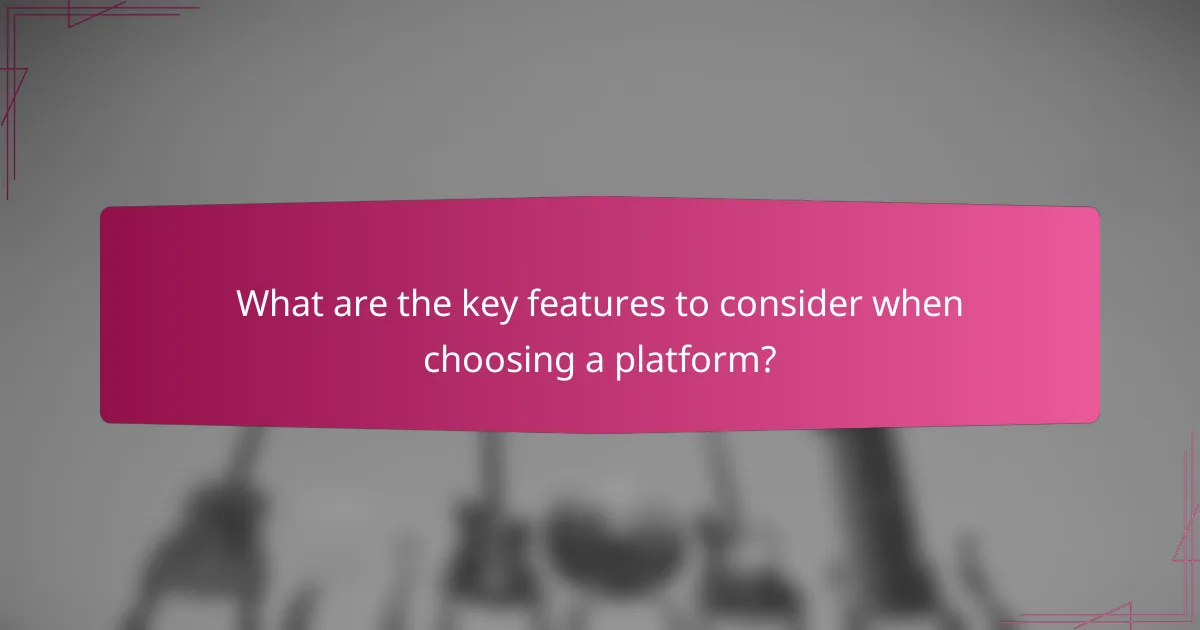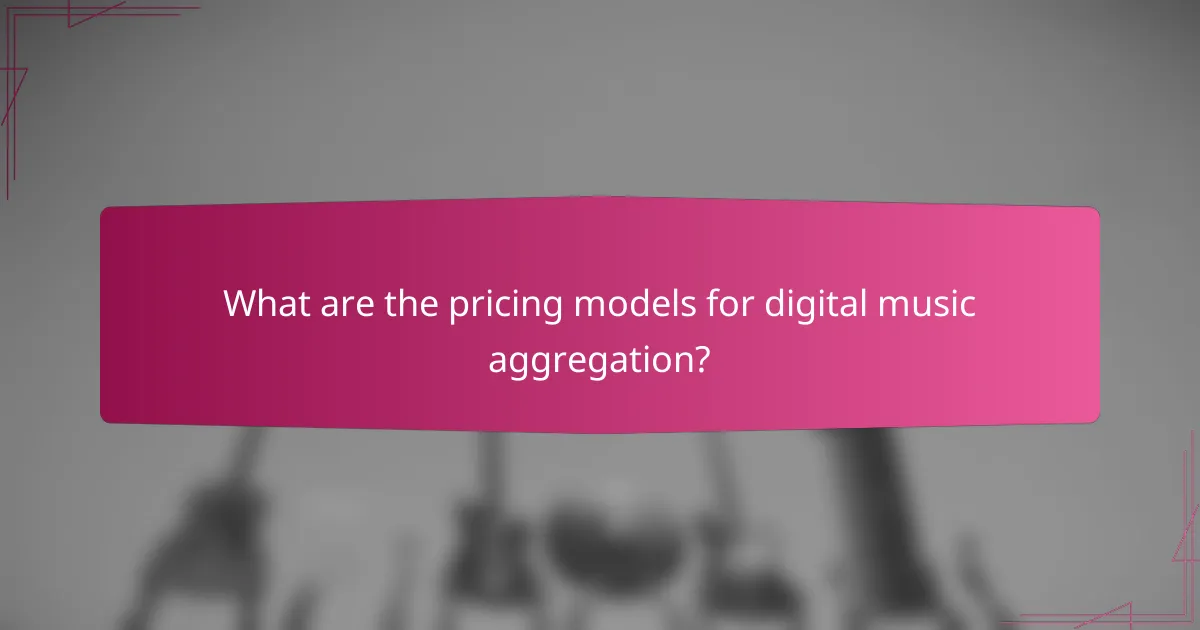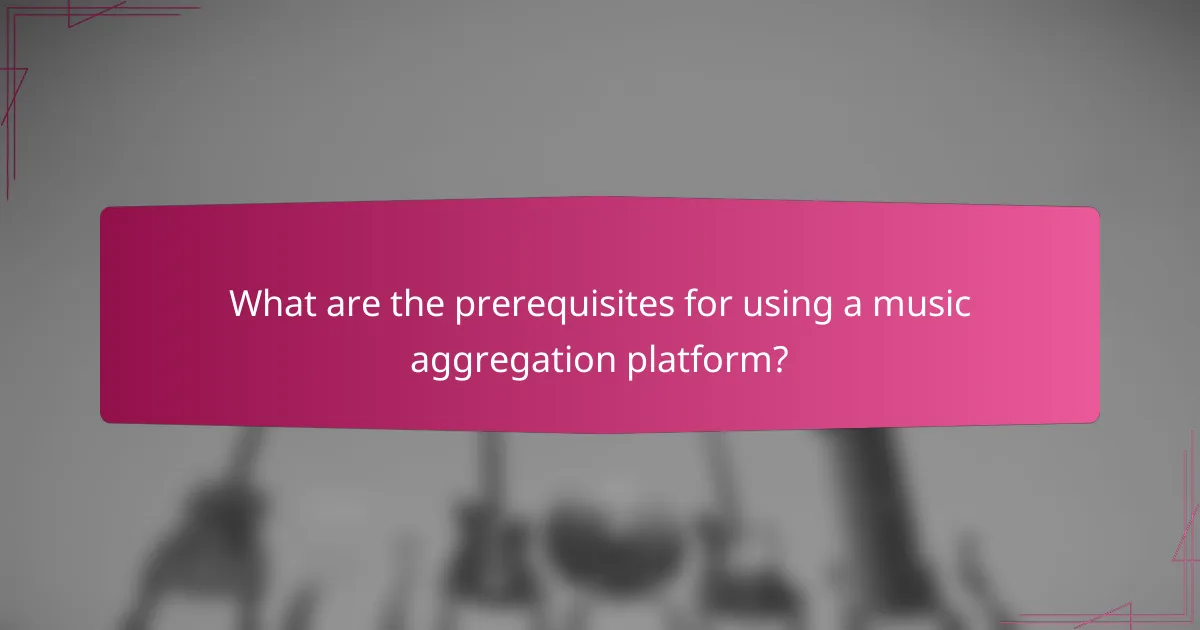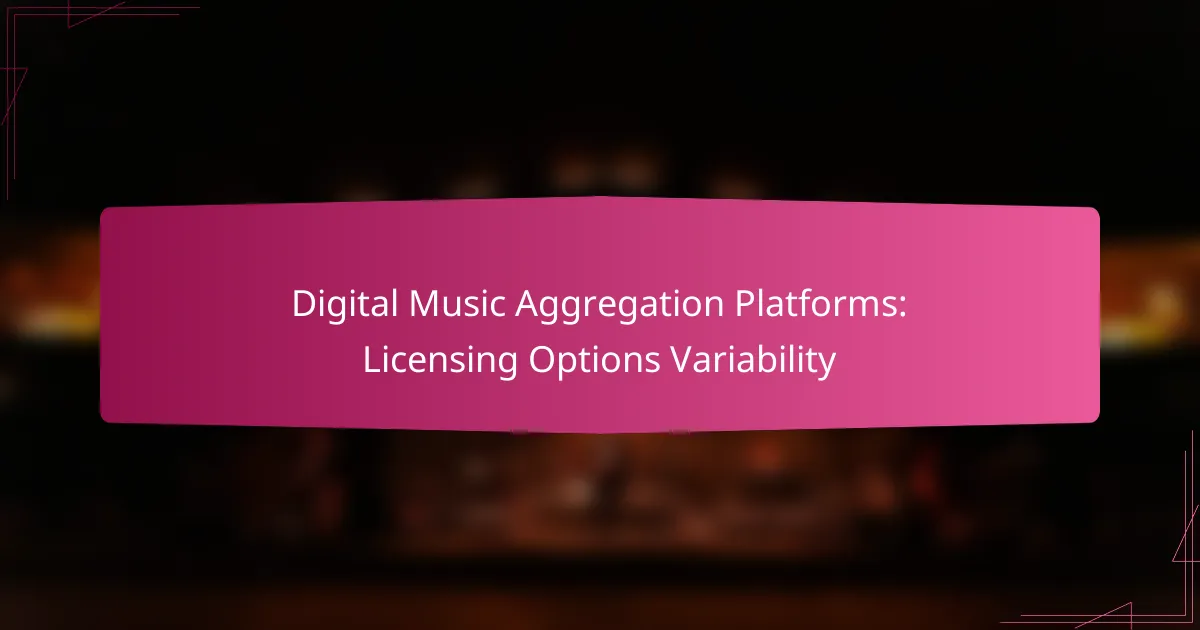Digital music aggregation platforms play a crucial role in how artists distribute their music and earn revenue. With options like DistroKid, CD Baby, and TuneCore, each platform presents varying licensing features, revenue shares, and distribution fees that can significantly influence an artist’s success. Understanding these differences is essential for making informed choices that align with an artist’s goals and needs.

What are the best digital music aggregation platforms for licensing?
The best digital music aggregation platforms for licensing include DistroKid, CD Baby, TuneCore, Amuse, and LANDR. Each platform offers unique features and pricing structures that cater to different needs of artists and labels.
DistroKid
DistroKid is known for its straightforward pricing model, allowing artists to upload unlimited tracks for a flat annual fee. This platform distributes music to a wide range of streaming services, including Spotify and Apple Music, while retaining 100% of the royalties for the artist.
One key advantage of DistroKid is its speed; songs can be live on streaming platforms within a few days. However, artists should be aware that DistroKid charges additional fees for certain services, such as YouTube Content ID and Shazam.
CD Baby
CD Baby operates on a per-release basis, charging a one-time fee for each album or single uploaded. This platform offers comprehensive distribution to various digital stores and streaming services, along with options for physical distribution.
Artists receive 91% of their royalties, with CD Baby taking a small cut. They also provide additional services like sync licensing and music publishing, making them a solid choice for artists looking for a full-service solution.
TuneCore
TuneCore charges artists an annual fee per release, which can add up if an artist frequently releases new music. However, it offers extensive distribution options and allows artists to keep 100% of their earnings.
One notable feature is TuneCore’s publishing administration service, which helps artists collect royalties from various sources. Artists should consider their release frequency and budget when choosing TuneCore.
Amuse
Amuse offers a unique model by providing free distribution for artists, taking a small percentage of royalties instead. This platform is particularly appealing for independent musicians who are just starting out.
Amuse also has a Pro version that offers additional features like faster release times and access to analytics. Artists should weigh the benefits of the free model against the potential long-term costs of sharing royalties.
LANDR
LANDR combines music distribution with mastering services, making it a convenient option for artists looking to enhance their sound before release. They offer a subscription model that includes unlimited distribution and mastering for a monthly fee.
While LANDR is beneficial for those seeking high-quality mastering, artists should consider whether the subscription cost aligns with their release strategy. The platform allows artists to retain 100% of their royalties, which is a significant advantage.

How do licensing options vary across platforms?
Licensing options differ significantly across digital music aggregation platforms, affecting how artists earn revenue and distribute their music. Key factors include revenue shares, distribution fees, and opportunities for licensing in sync projects.
Revenue share differences
Revenue shares can vary widely between platforms, typically ranging from 70% to 90% of the earnings going to the artist. Some platforms may offer higher percentages for independent artists, while others might have tiered structures based on sales volume. It’s essential to read the fine print to understand how much you will actually earn from streams and downloads.
For example, a platform that takes a 30% cut might seem attractive, but if it has additional fees or lower visibility, the overall earnings could be less favorable. Always compare revenue models before committing to a service.
Distribution fees
Distribution fees are another critical aspect to consider, as they can be either a flat fee or a percentage of sales. Many platforms charge an annual fee, which can range from a few dollars to several hundred, depending on the services offered. Some may also charge per release, which can add up if you plan to release multiple tracks or albums.
When evaluating distribution fees, consider what additional services are included, such as marketing support or access to analytics. A slightly higher fee might be worth it if it comes with valuable resources that can help boost your music’s reach.
Licensing for sync opportunities
Licensing for sync opportunities, which allows your music to be used in films, TV shows, and commercials, varies by platform. Some aggregation services have established connections with music supervisors and offer dedicated sync licensing programs, while others may not provide this option at all. This can significantly impact your potential earnings.
Artists should inquire about a platform’s track record in securing sync placements and whether they actively pitch music for these opportunities. Platforms that specialize in sync licensing might take a higher cut but can provide access to lucrative deals that outweigh the costs.

What are the key features to consider when choosing a platform?
When selecting a digital music aggregation platform, focus on features like royalty collection methods, geographic reach, and customer support quality. These elements significantly impact how effectively your music is distributed and monetized.
Royalty collection methods
Royalty collection methods vary widely among platforms, affecting how and when you receive payments. Some platforms offer direct payments based on streaming and download metrics, while others may use a more complex system involving third-party licensing agreements.
Consider whether the platform provides transparent reporting and timely payments. Look for platforms that offer multiple revenue streams, such as performance royalties, mechanical royalties, and sync licensing, to maximize your earnings.
Geographic reach
The geographic reach of a platform determines where your music can be distributed and monetized. Some platforms focus on specific regions, while others have a global presence, allowing access to a wider audience.
Evaluate the platform’s partnerships with local distributors and streaming services in key markets. A platform with extensive international reach can help you tap into emerging markets, which may offer lucrative opportunities for growth.
Customer support quality
Quality customer support is crucial when navigating the complexities of digital music distribution. Look for platforms that provide responsive support through multiple channels, such as email, chat, and phone.
Check for user reviews or testimonials regarding the support experience. A platform with dedicated account managers or personalized assistance can help you address issues quickly and effectively, ensuring a smoother distribution process.

What are the pricing models for digital music aggregation?
Digital music aggregation platforms typically use various pricing models to charge artists and labels for their services. The most common models include flat fees, a percentage of earnings, and subscription-based pricing, each with its own advantages and considerations.
Flat fees
Flat fees involve a one-time payment for distribution services, regardless of the number of tracks or sales generated. This model is straightforward and allows artists to budget their costs easily, making it appealing for those releasing multiple songs or albums.
However, artists should consider the upfront cost and whether it aligns with their expected revenue. For example, fees can range from around $10 to $50 per release, depending on the aggregator.
Percentage of earnings
Percentage-based models charge a fee based on the revenue generated from music sales or streams. This means that the aggregator takes a cut of the earnings, which can typically range from 10% to 30%.
This model can be beneficial for new artists who may not have significant upfront costs but should be cautious of how much of their earnings they are willing to share. It’s essential to calculate potential earnings to determine if this model is sustainable long-term.
Subscription models
Subscription models require artists to pay a recurring fee, often monthly or annually, for ongoing access to distribution services. This can be advantageous for those who plan to release music frequently, as it often includes additional features like analytics and promotional tools.
Subscription costs can vary widely, typically ranging from $5 to $50 per month. Artists should evaluate their release schedule and potential income to decide if a subscription is a cost-effective choice for their needs.

What are the prerequisites for using a music aggregation platform?
To use a music aggregation platform, artists must typically own the rights to their music and have a clear understanding of the distribution agreements involved. These prerequisites ensure that the artist can legally distribute their music while maximizing their revenue potential.
Music copyright ownership
Owning the copyright to your music is crucial when using a music aggregation platform. This means you should either be the sole creator or have secured rights from co-writers and producers. If you don’t own the rights, you may face legal issues or be unable to distribute your music effectively.
To verify ownership, consider registering your music with a copyright office, which can provide legal protection and help in disputes. Additionally, keep documentation of any agreements with collaborators to avoid conflicts later on.
Distribution agreements
Distribution agreements outline the terms under which your music will be distributed through the aggregation platform. These agreements typically cover revenue splits, duration of the contract, and the specific platforms where your music will be available. Understanding these terms is essential for maximizing your earnings.
When reviewing distribution agreements, pay attention to the percentage of royalties you will receive. Common splits range from 70-90% for artists, depending on the platform and services provided. Always read the fine print and consult with a legal expert if necessary to ensure you are making informed decisions.

How do artists maximize their earnings through aggregation?
Artists can maximize their earnings through digital music aggregation by understanding the various licensing options available and selecting the right platform that aligns with their distribution goals. By strategically managing their rights and revenue streams, artists can significantly enhance their income from music sales and streaming.
Understanding licensing terms
Licensing terms dictate how artists can use their music and how they earn from it. Key terms include mechanical licenses, synchronization licenses, and performance rights, each affecting revenue differently. For example, mechanical licenses allow for the reproduction of music on physical formats or digital downloads, while synchronization licenses are needed for music used in visual media.
Artists should carefully review the licensing agreements provided by aggregation platforms to understand their rights and obligations. This includes knowing what percentage of royalties they will receive and whether the platform retains any rights to the music. A common practice is to negotiate terms that favor the artist, ensuring they retain as much control and revenue as possible.
Additionally, artists should consider the implications of exclusive versus non-exclusive licensing. Exclusive agreements may offer higher upfront payments but can limit future opportunities, while non-exclusive deals provide flexibility but might yield lower initial earnings. Weighing these options is crucial for maximizing overall income.
